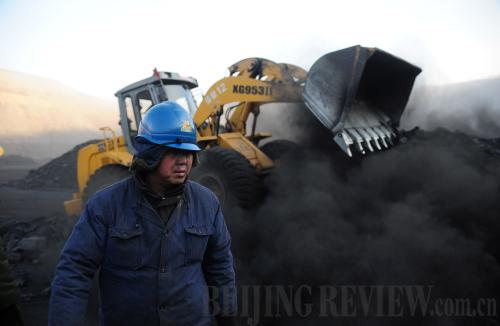|
 |
|
DIGGING DEEPER: Liu Wenze works at the Haizhou open-pit coal mine in Fuxin, Liaoning Province. Fuxin is in the process of developing a hydraulics industry to take over from its coal-dependent economy before their coal reserves are used up (JIANG BING) |
As in developed countries, there are many cities in China that rely on natural resources for development. With the exhaustion of resources, some of them are facing difficulties, presenting a challenge for economic transformation.
The State Council released on December 3 the Sustainable Development Planning for National Resource-Based Cities (2013-20), the first national-level plan in China to guide the sustainable development of resource-dependent cities.
Du Ying, Vice Minister of the National Development and Reform Commission (NDRC), said the plan aims to solve problems all resource-dependent cities are facing, including disorderly and excessive exploitation of resources and damages to the ecological environment. Moreover, industrial structure in these cities is unbalanced, with resource-based industries accounting for a large proportion of the local economy while other industries lag far behind. Once resources dwindle, these cities may decline, posing a threat to their sustainable development.
Based on the potential for sustainable development and resource conditions, China's resource-based cities are divided into four categories: growing, mature, declining and regenerative.
Growing resource-dependent cities are considered bases for China's energy supply and reserves and mature resource-dependent cities are core areas for guaranteeing China's energy security. Declining resource-dependent cities are listed as key areas for transformation. Regenerative resource-dependent cities are set as pioneers and models for transformation.
Differentiated tasks
Du said the NDRC has set differentiated tasks for different types of resource-dependent cities. As for the growing ones, the NDRC will mainly boost their development, raise the access to resource extraction industries, ensure exploitation of resources at a reasonable rate and strictly implement environmental impact assessments.
In the mature ones, the NDRC will advance the adjustment and upgrade of their industrial structure; solve problems caused by resource extraction; extend industrial chains, nurture enterprises for deep processing of resources; and incorporate environmental costs into the total production costs.
In the declining cities, the government will vigorously develop alternative industries. According to the NDRC figures, the population of the 67 declining resource-dependent cities only accounts for 4 percent of the country's total, but they have one fourth of the country's shantytowns, one 10th of the country's unemployed mine workers, and one third of the country's subsided areas.
As for the regenerative cities, the NDRC will guide their innovation-oriented development, improve the quality and efficiency of their economic development and establish a long-lasting mechanism for sustainable development.
Du said for the development of resource-dependent cities, the government should not only solve the problems in cities where resources are depleting, but also boost sustainable development of all resource-dependent cities.
Model cities
Among all the resource-dependent cities, people are more concerned about the development of the declining ones. However, NDRC officials, who are responsible for guiding industrial development, have shown enough confidence in their transformation, as they already have two successful examples: China's Fuxin and Ruhr in Germany.
| 